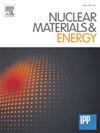Annealing of He-related defects and their influence on deuterium retention in displacement-damaged EUROFER97
IF 2.7
2区 物理与天体物理
Q1 NUCLEAR SCIENCE & TECHNOLOGY
引用次数: 0
Abstract
This work investigates the thermal evolution of He-related defects and their impact on deuterium (D) retention in EUROFER97. Samples were irradiated at 290 K with 20 MeV tungsten (W) ions to a primary peak damage dose of 0.6 dpa followed by 0.5 MeV He ions to a peak concentration of 0.6 at.% to mimic the aspects of fusion neutron damage. These samples were then exposed to a low-temperature D plasma to fill the radiation-induced defects with D. Nuclear reaction analysis with He (He-NRA) was applied to determine the depth profiles of the retained D. Thermal desorption spectroscopy (TDS) was employed to investigate D desorption. The experimental cycle of D-loading/NRA/TDS was systematically repeated, and the maximum TDS temperature was increased by 50 K in each step (from 420 K up to 720 K). This allowed studying the thermal evolution of the D trapping sites. Although the density of He-related traps decreases monotonically with increasing temperature, they are not completely recovered even after annealing at 720 K. It was concluded that the presence of He bubbles, which were observed by transmission electron microscopy (TEM), significantly increases the local D concentration. The simulation of TDS spectra utilizing a macroscopic rate equation code (TESSIM-X) reveals a D detrapping energy from He-related defects of 1.00 eV.
位移损伤EUROFER97中he相关缺陷的退火及其对氘保留的影响
本文研究了EUROFER97中he相关缺陷的热演化及其对氘(D)保留的影响。样品在290 K下用20 MeV的钨离子照射至初始峰值损伤剂量为0.6 dpa,然后用0.5 MeV的He离子照射至峰值浓度为0.6 at。%来模拟聚变中子损伤的各个方面。然后将这些样品暴露在低温的D等离子体中,用D填充辐射引起的缺陷。采用3He核反应分析(3He- nra)来确定保留D的深度分布。系统重复D-loading/NRA/TDS的实验循环,TDS最高温度每步提高50 K(从420 K提高到720 K)。这使得研究D捕获点的热演化成为可能。虽然he相关陷阱的密度随温度的升高而单调降低,但即使在720 K退火后也不能完全恢复。通过透射电镜(TEM)观察,He气泡的存在显著增加了局部D浓度。利用宏观速率方程代码(TESSIM-X)对TDS谱进行模拟,发现he相关缺陷的D脱陷能量为1.00 eV。
本文章由计算机程序翻译,如有差异,请以英文原文为准。
求助全文
约1分钟内获得全文
求助全文
来源期刊

Nuclear Materials and Energy
Materials Science-Materials Science (miscellaneous)
CiteScore
3.70
自引率
15.40%
发文量
175
审稿时长
20 weeks
期刊介绍:
The open-access journal Nuclear Materials and Energy is devoted to the growing field of research for material application in the production of nuclear energy. Nuclear Materials and Energy publishes original research articles of up to 6 pages in length.
 求助内容:
求助内容: 应助结果提醒方式:
应助结果提醒方式:


